|
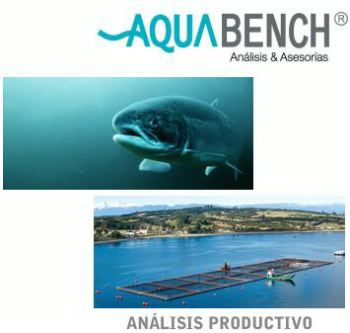
Balance of productive results of the Chilean Salmon industry in 2019 prepared by Aquabench
2019 Salmon Industry Balance
 CHILE
CHILE
Wednesday, April 08, 2020, 00:00 (GMT + 9)
For the Second Consecutive Year, High Harvest Weights, Low Mortality, and Productivity Improvements Marked the Results of the Year.
The good productive results of the industry registered in 2018 season (in the 3 cultivated species) were maintained, which was again mainly associated with the reduction of mortality, higher harvest weight and, as a result, increase in harvested kilos /transferred smolt.
Mortality
Atlantic Salmon had a 11.5% of accumulated mortality in closed groups in 2019, slightly lower than registered in previous year (13%). In the case of Rainbow Trout a higher accumulated mortality was recorded in 2019, reaching 12.6% (vs. 7.6% in 2018) and Coho Salmon, accumulated mortality remained without variations compared with previous season, reaching 7.9%.
The analysis shows that the average monthly mortality in 2019 for Atlantic Salmon was 0.73%, Coho Salmon was 0.87% and 1.04% for Rainbow Trout. This monthly mortality was higher than in 2018 for two species: Coho Salmon (0.76%) and Rainbow Trout (0.91%). In Atlantic Salmon the mortality was higher in the last year (0.74%)
Therefore, 2019 productivity balance shows a total amount of dead fish equivalent to 24.7 million during the growout stage. Per species, 16.2 million correspond to Atlantic Salmon, 4.9 million to Coho Salmon and 3.5 million to Rainbow Trout. 21% of this mortality was caused by infections.
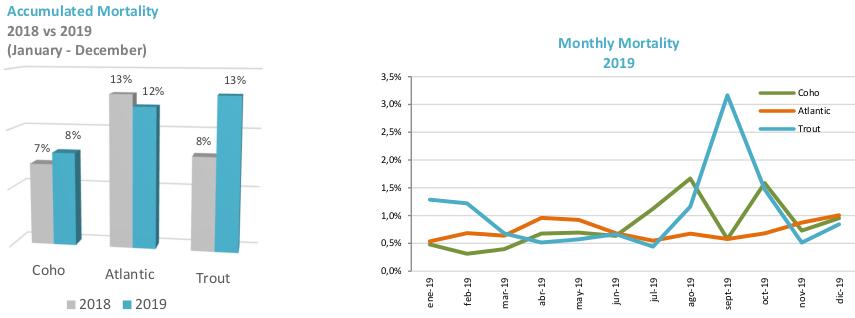
Click to enlarge
* The numbers mentioned in this document correspond to those obtained directly from our own Databases (DB). To extrapolate to 100% of the industry, it is necessary to use the estimated DB representativeness, which is 92.3% in average (Coho Salmon: 100%; Atlantic Salmon: 89.4% and Rainbow Trout: 100%). All the information presented includes the 3 farming regions.
Smolt Stocking
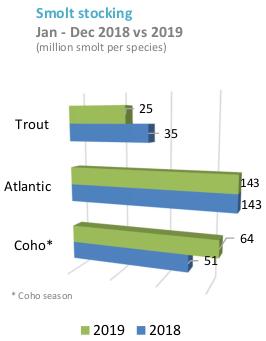 In 2019, there was an average decrease of 3% in smolt stocking, in relation to the previous year, reaching a total amount of 228.8 million smolt transferred to the sea compared with 235.1 recorded during 2018 for the three species farmed. In 2019, there was an average decrease of 3% in smolt stocking, in relation to the previous year, reaching a total amount of 228.8 million smolt transferred to the sea compared with 235.1 recorded during 2018 for the three species farmed.
Per species, the numbers show an decrease of 28% in Rainbow Trout and increase of 23% in Coho Salmon (season). Atlantic Salmon showed no variations (0%) The weight of the fish when transferred to the sea in 2019 was higher in relation to the previous year for the three species: Atlantic Salmon 163 g. (↑10%), Rainbow Trout 215 g. (↑3%) and Coho Salmon 197 g. (↑16%).
Biomass and the Number of Fish
The information shows that, at the end of 2019 (December), there was an increase of 2% (compared with the previous year) of the number of live fish, with an estimation of a total of 223 million fish
(considering the 3 species). By species, Rainbow Trout was the specie that shown more variation (10% decrease) in the number of live fish in December 2019 (26 million live fish). Coho Salmon had almost no variations (18 million of live fish). On the other hand, Atlantic Salmon showed a slight increase of the number of live fish (4%), reaching 180 million live fish at the end of December 2019.
Indu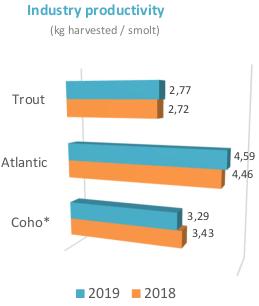 stry productivity Regarding living biomass during the growout stage, the analysis reveals an increase of 20% in relation to December 2018, with a total of 542,311 tons at the end of 2019 for the three species. Per species, Atlantic Salmon – that represents 80% of the total living biomass – shows an increase of 18% up to December 2019, in relation to the same month of the previous year, reaching 431,418 tons. Likewise, the biomass of Rainbow Trout and Coho Salmon also increased 28% and 29% respectively. stry productivity Regarding living biomass during the growout stage, the analysis reveals an increase of 20% in relation to December 2018, with a total of 542,311 tons at the end of 2019 for the three species. Per species, Atlantic Salmon – that represents 80% of the total living biomass – shows an increase of 18% up to December 2019, in relation to the same month of the previous year, reaching 431,418 tons. Likewise, the biomass of Rainbow Trout and Coho Salmon also increased 28% and 29% respectively.
Productivity
The higher harvest weight and lower mortality recorded during 2019 was reflected in the increase of productivity in Atlantic Salmon, which reached 4.59 kg (at the end of 2019) harvested per smolt transferred to the sea, amount that is 3% higher than the amount registered in 2018. In the case of Rainbow Trout, an slight improvement in productivity of 2% was also observed, reaching 2.77 kg harvested per smolt, whereas for Coho Salmon, it decreased 4%, reaching 3.29 kg harvested per smolt (as a season).
Harvest
T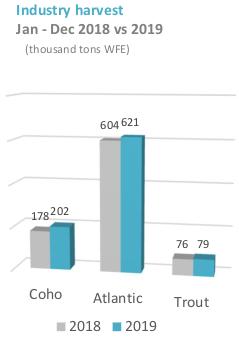 he total biomass harvested by the whole industry for the three species in 2019 reached 903 thousand tons (WFE*), amount which is 5% higher than the previous year. Per species, the accumulated harvested volumes (WFE) at the end of the year reached 621,677 tons for Atlantic Salmon, 78,905 tons for Rainbow Trout and 202,785 tons for Coho Salmon. These numbers represent an increase in harvest for the period of 24,504 tons for Coho Salmon, 17,316 tons for Atlantic Salmon and 2,793 tons for Trout. he total biomass harvested by the whole industry for the three species in 2019 reached 903 thousand tons (WFE*), amount which is 5% higher than the previous year. Per species, the accumulated harvested volumes (WFE) at the end of the year reached 621,677 tons for Atlantic Salmon, 78,905 tons for Rainbow Trout and 202,785 tons for Coho Salmon. These numbers represent an increase in harvest for the period of 24,504 tons for Coho Salmon, 17,316 tons for Atlantic Salmon and 2,793 tons for Trout.
In 2019, the average harvest weight for Atlantic Salmon was 5.2 kg, it was 3.5 kg for Coho Salmon and 3.1 kg for Rainbow Trout. WFE = Whole Fish Equivalent: Unit used to measure the raw material, it corresponds to round bled live weight % Accumulated Mortality = Total N° of dead fish / initial N° of fish transferred Biomass Produced = Dead biomass + Harvested biomass + Living biomass at the end of a period % Dead Biomass = Kg of dead biomass / Kg of biomass produced °Smolt Stocking: transfer of fish (called smolts at this stage of their life cycle) to sea water farming sites to begin the growout stage.
Source: Aquabench S.A.

editorial@seafood.media
www.seafood.media
|



